 Research Article
Research Article
Comparative Study of Inorganic TiO2 Nanoparticles and Organic Sawdust Dispersed Epoxy Based Composites
Moumita Tasnim Meem1, Md Asadul Hoque1, Gagi Tauhidur Rahman1, Md Abdul Gafur2, Md Abdul Matin1 and Md Anwarul Kabir Bhuiya1*
1Department of Materials Science and Engineering, Rajshahi University, Bangladesh
2Bangladesh Council of Scientific and Industrial Research, Bangladesh
Md Anwarul Kabir Bhuiya, Department of Materials Science and Engineering, Rajshahi University, Rajshahi, Bangladesh.
Received Date: May 08, 2019; Published Date: May 21, 2019
Abstract
This work reports the synthesis and characterization of inorganic Titania (TiO2) nanoparticles and formation of epoxy-based composites loaded with 1wt%, 3wt%, 5wt% and 10wt% TiO2 nanoparticles and sawdust by weight. The TiO2 nanoparticles were prepared using sol-gel method and characterized by SEM and XRD analysis to ensure the size and formation of nanoparticles. These composites were subjected to mechanical testing to study various properties like tensile strength, flexural strength, young’s modulus, hardness on various loading percentages. In all respects, inorganic Epoxy/ TiO2 nanocomposites showed better performance than organic sawdust/epoxy composites.
Keywords:Epoxy resin; TiO2 nanoparticles; Sawdust; Mechanical properties
Introduction
Polymer matrix composites are the dobbins of composite industries. Besides, polymer matrix modifications have become one of the most challenging and interesting approaches for materials engineers as various type fillers can be incorporated as a secondary phase into the polymer matrices to dramatically enhance their properties. Epoxy resin (EP) is a thermoset resin with good thermal and environmental stability, wear and abrasion resistance, lightweight [1] but they lack hardness. The use of additional fillers (organic, inorganic) to the epoxy resin matrix can develop their hardness with some additional properties like lightweight, flame retardant, opacity, electrical and thermal insulation etc. So, they can be utilized in various structural sectors replacing metalbased structural components where strength is not only the prime consideration.
The addition of both TiO2 (inorganic) and sawdust (organic) fillers into epoxy matrix results in the development of composites with more flourished mechanical, thermal [2], optical [3] properties and these enhancements lead to various dynamic applications including biomedicine, electronics, especially for structural sectors. However, it is very difficult to uniformly disperse the nanoparticles into the epoxy matrix due to strong attraction between the particles and the limited shear force during compounding [1] but we will try to ensure maximum dispersion of them in the epoxy matrix. Besides, sawdust are waste products of various woodworking like sawing, drilling, milling, routing etc. [4] and so here we will try to use this waste product as an organic filler for epoxy matrix. A comparative study of mechanical properties of inorganic (TiO2) and organic (sawdust) filler incorporated epoxy-based composites has been done to determine their individual effects on epoxy matrix for different weight percentages and select the best one.
Materials and Methods
Materials
Epoxy resin (Diglycidal Ether of Bisphenol A, DGEBA) and hardener DiethyleneTriamine (DETA) was from Merck, India. Titanium tetra isopropoxide (Ti[OCH(CH3)2]4) and Isopropyl alcohol ((CH3)2CHOH) utilized in sol-gel process to synthesize TiO2 nanoparticles were from Sigma-Aldrich (Germany). All the chemicals were in AR grade. The sawdust was collected from local wood mills of Rajshahi city, Bangladesh.
Methods
Preparation of titania (TiO2) nanoparticles: TiO2 nanoparticles were prepared using sol-gel technique where titanium tetra isopropoxide was dropped slowly into the solution of water and isopropyl alcohol under continuous magnetic stirring. It was kept on a magnetic stirrer for 60 mins at room temperature under a constant stirring speed. The solution was aged for 24 hours and then dried at 60 °C for 12 hour and calcined at 550 °C for 2 hours (Figure 1). Finally, they were finely powdered by milling in mortar pestle [5].
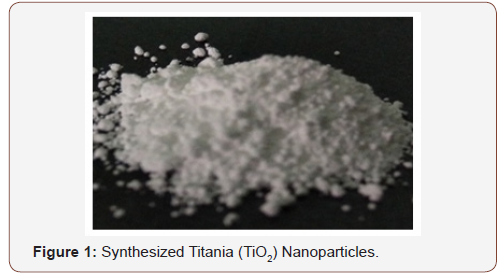
Preparation of composites:
• For the preparation of neat (blank) epoxy composite about 19.8g of epoxy resin was mixed with 2.2 g of hardener (Diethylenetriamine, DETA) for at least 30 minutes and poured on a glass mold for curing. After 24 hours blank composite (without filler) sheet of about 1.56mm was obtained.
• To fabricate inorganic (Epoxy/TiO2) (1wt%) nanocomposite at first, around 19.6g of epoxy resin was taken and mixed with 0.22g of previously prepared TiO2 nanoparticles for about 20 minutes to ensure proper mixing. Then 2.18g of hardener was added dropwise and again mixed continuously for 30 minutes. The mixture then poured on a self-made glass mold and cured for 24 hours to form Epoxy/TiO2nanocomposites of about 1.3 mm thickness. Similarly, 3wt%, 5wt%, 10wt% Epoxy/ TiO2 nanocomposites were prepared.
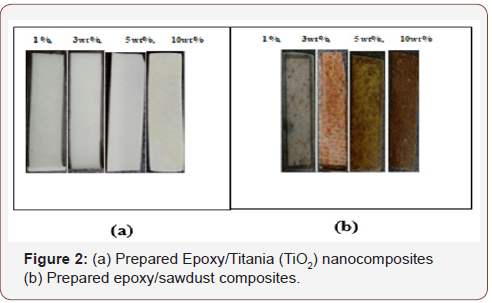
• Same procedure was followed for preparing organic Epoxy/sawdust (1wt%, 3wt%, 5wt%, 10wt%) composites only replacing the inorganic filler with organic sawdust in to epoxy matrix (Figure 2).
Characterization: The formation of nanoparticle was ensured by XRD (X-Ray Diffraction) and SEM (Scanning Electron Microscopy) analysis where XRD was done in a D8 Diffractometer and SEM was performed on a ZEISS Electron Microscope. Tensile testing for tensile strength and young’s modulus, three-point bending analysis for flexural strength, Rockwell hardness to measure hardness was done for both inorganic (Epoxy/TiO2) and organic (Epoxy/sawdust) composite samples.
All tensile tests were performed in a computerized UTM machine by applying load at a cross section head speed 2mm/ min and the tests were repeated 5 times for 5 samples to ensure accurate measurement. Flexural strength was measured following ASTM D-790 procedures and repeated for 3samples. Digital Shore Durometer was used to measure the Rockwell hardness of the composite samples. All tests were done under room temperature.
Results and Discussion
XRD analysis of TiO2 nanoparticles
The XRD analysis was one to ensure the formation of TiO2 nanoparticles by estimating their crystallite size. All peaks were recorded within a range of 2θ from 200 to 700 with CuKα radiation (λ = 1.54060A0). The XRD patterns of TiO2 nanoparticles are given in the Figure 3.

It has been found from the above patterns (Figure 3) pure crystalline anatase TiO2 nanoparticle was formed in an accordance with JCPDS [6]. The XRD data obtained for TiO2 nanoparticles calcined at 550 0C is given below in Table 1:
Table 1: XRD data of TiO2 nanoparticles.
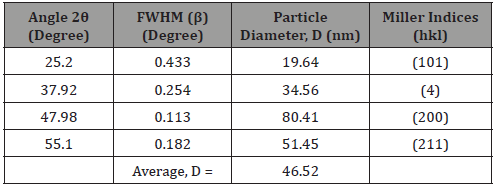
The crystallite size of TiO2 nanoparticles calculated by De-bye Scherrer formula was found to be 46.52nm. This has ensured the formation of pure TiO2 (anatase) Nano powder.
SEM analysis of TiO2 nanoparticles
SEM image of TiO2 nanoparticles done within 30.00 KX magnification has been shown in the figure (Figure 4) that estimates an average size of the nanoparticles near70-80 nm. It can also be observed that most of the particles were agglomerated.

Mechanical tests of composites
<Tensile test: Tensile strength of the composites have been decreased due to the addition of both organic (sawdust) and inorganic (TiO2) filler into epoxy matrix than that of blank epoxy composite (Figure 5).
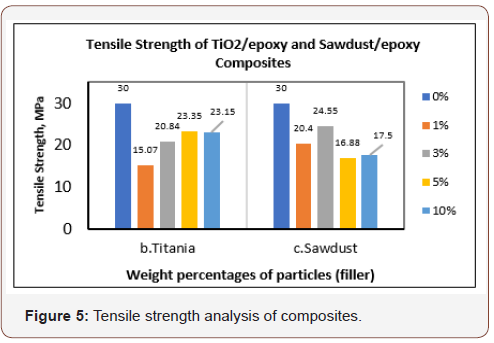
It has been observed from the figure that, the tensile strength of neat epoxy was 30 MPa and addition of inorganic (TiO2) nanoparticles and organic sawdust into epoxy matrix started to decrease the tensile strength. The lowest tensile strength was observed for 1wt%Epoxy/TiO2 and 5wt% Epoxy/sawdust composites. The average decrease rate for Epoxy/TiO2 and Epoxy/ sawdust was 31.33% and 33.88 %. This can be reasoned as the agglomeration of fillers that imbeds the dispersion of filler in the matrix [7] ultimately reducing the interfacial bonding between the fillers and matrix. Besides, the low value of tensile strength is due to the formation of chain entanglement in matrix (epoxy) system [8]. But the average decrease rate for Epoxy/TiO2 is lower than that of Epoxy/sawdust because nano size of the inorganic nanoparticles leads to lower agglomeration than the organic sawdust.
Flexural strength test: The flexural strength of the composite samples was also decreased for adding TiO2 and sawdust filler in the epoxy matrix (Figure 6).
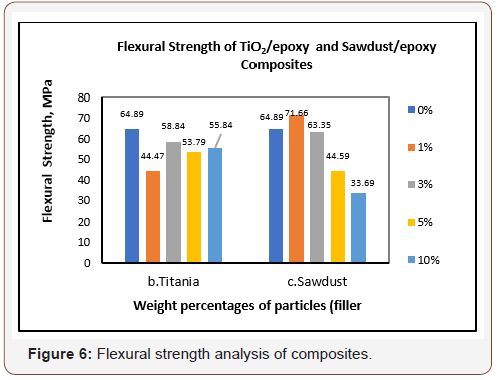
The observed flexural strength of neat epoxy from the figure is 64.89 MPa. The flexural strength started to decrease with the addition of TiO2 and sawdust filler into the epoxy matrix but following different descend rate. The average decrease rate of flexural strength for adding TiO2 nanoparticles was 17.96% and that for sawdust addition was 17.88%. The addition of inorganic TiO2 nanoparticles breaks the continuity of epoxide ring reducing their mobility and bending ability [9] and for higher percentages they are easily aggregated due to their high surface energy [10] reducing the flexural strength. On the other hand, flexural strength should be increased for adding sawdust due to their organic nature correlating with organic epoxy. So, for 1wt% Epoxy/sawdust the flexural strength was slightly increased [11] but with further addition of sawdust increases agglomeration causing the decrease of bending ability. Increased amount of sawdust imbeds proper mixing as they are not in nano size ultimately reducing the flexural strength.
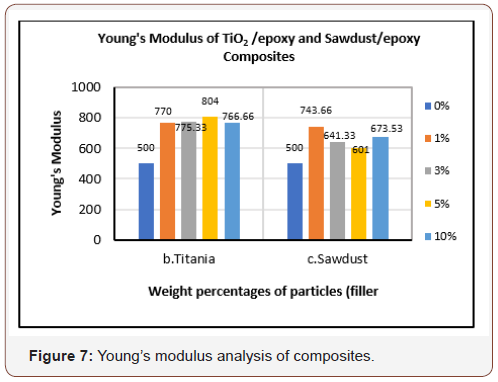
Young’s modulus: The Young modulus has increased than that of neat epoxy (0wt% filler) due to the addition of TiO2 nanoparticles and sawdust (Figure 7).
The observed increase in Young’s modulus is quite predictable, as tensile and flexural strength of neat epoxy has decreased due to the addition of organic and inorganic fillers. The average increase rate of Young’s modulus for Epoxy/TiO2 and Epoxy/sawdust was 55.79% and 32.98%. The ceramic nature of TiO2 nanoparticles creates a strong bonding with the epoxy matrix increasing the plasticizing effect reducing the strain ability of the nanocomposites [12]. In addition, organic sawdust also interacts with the epoxide rings of matrix imbedding the mobility of long epoxy chain. That ultimately decreases the strain ability of epoxy making the composites less flexible [13]. Besides, the increment rate of Young’s modulus of Epoxy/TiO2 is higher than that of Epoxy/sawdust mainly due to their nano size and high surface area.
Hardness test: The Rockwell hardness of the composites increased than that of neat epoxy (0 wt% filler) due to addition of TiO2 and sawdust particles into the epoxy matrix (Figure 8).
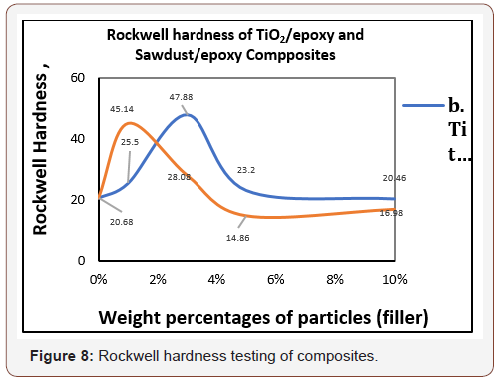
The hardness of neat epoxy was found only 20.68 HRC. Nevertheless, the addition of both TiO2 and sawdust filler increases the hardness. Maximum hardness exhibited by 3wt% Epoxy/ TiO2and 1wt% Epoxy/sawdust was 47.88 HRC and 4514 HRC respectively. However, after that further addition of fillers decrease the hardness due to agglomeration leading to poor dispersion of fillers in the epoxy matrix. The proper load transfer between the fillers and matrix is embedded that ultimately makes the composites harder than that of neat epoxy. Again, particle size is a very important factor for hardness. The smaller the particle size the higher will be the hardness and so Epoxy/ TiO2 nanocomposites are harder than Epoxy/sawdust composites.
Conclusion
The comparative investigation of Epoxy/TiO2 and Epoxy/ sawdust composites on various mechanical properties has been revealed that incorporation of both inorganic TiO2 and organic sawdust particles in epoxy had increased their hardness, Young’s modulus satisfactorily and predictably reduced their tensile and flexural strength. That means addition of fillers converted the ductile epoxy into harder composites with acceptable hardness. But the Epoxy/TiO2 nanocomposites exhibited better hardness and modulus than that of sawdust/epoxy due to their nano size, high weight to volume ratio and smooth surface.
Acknowledgement
None.
Conflict of Interest
No conflict of interest.
References
- Shao-Rong Lu, Jing-Hongyu, Hai-Liang Zhang, Xia-Yu Wang (2005) Wear and mechanical properties of epoxy/SiO2-TiO2 composites. Journal of Materials Science 40(11): 2815-2821.
- Afzal A, Siddiqi HM, Iqbal N, Ahmad Z (2013) The effect of SiO2 filler content and its organic compatibility on thermal stability of epoxy resin. J Therm Anal Calorim 111(1): 247-252.
- Chau JLH, Tung CT, Lin YM, Li AK (2008) Preparation and optical properties of titania/epoxy nanocomposite coatings. Mater Lett 62(19): 3416–3418.
- https://en.wikipedia.org/wiki/Sawdust
- Kamil F, Hubiter KA, Abed TK, Al-Amiery AA (2016) Synthesis of aluminum and titanium oxides nanoparticles via sol-gel method: optimization for the minimum size. J NanosciNanotechnol 2(1): 37-39.
- Zeljka A, Krsmanovic RM, Nikolic MG, Marinovic-Cincovic M, Dramicanin MD (2012) Multisite luminescence of rare earth doped TiO2anatase nanoparticles. Mater Chem Phys 135(1-3): 1064-1069.
- Rangari V (2011) Polymer Nanocomposite Materials for Structural Applications. Advances in Nanocomposites; Synthesis, Characterization and Industrial Applications.
- Beloshenko VA, Voznyak Yu V (2013) Microhardness of oriented amorphous-crystalline polymers. Materials Science 49(1): 110-116.
- Al-Namie Dr I, Ibrahim Dr AA, Hassan MF (2011) Study the Mechanical Properties of Epoxy Resin Reinforced with silica (quartz) and Alumina Particles. Iraqi j mech Mater eng 11(3): 1-21.
- In-Yup J, Beom J (2010) Nanocomposites Derived from Polymers and Inorganic Nanoparticles. Materials 3: 3654-3674.
- Ku H, Donald M, Cardona F, Trada M (2012) Flexural properties of sawdust-reinforced epoxy composites post-cured in microwaves; Journal of Composite Materials 46(22): 2879-2890.
- (2007) Materials Handbook, Francois Cardarelli, Springer Publications.
- Hisham S, Faieza AA, Ismail N, Sapuan SM, Ibrahim MS (2011) Tensile Properties and Micro morphologies of Sawdust and Chip wood Filed Epoxy Composites, Key Engineering Materials 471-472: 1070-1074.
-
Md Anwarul Kabir Bhuiya, Moumita Tasnim Meem Md Asadul Hoque, Gagi Tauhidur Rahman, Md Abdul Gafur, Md Abdul Matin, Comparative Study of Inorganic TiO2 Nanoparticles and Organic Sawdust Dispersed Epoxy Based Composites. Glob J Eng Sci. 2(3): 2019. GJES. MS.ID.000539.
-
Epoxy resin, TiO2 nanoparticles, Sawdust, Mechanical properties
-

This work is licensed under a Creative Commons Attribution-NonCommercial 4.0 International License.






